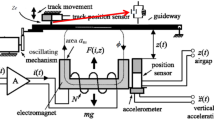Abstract
Usually, in controller design for maglev systems, only the dynamics of the magnet and the levitating object are modeled. However, reference frames, such as rails for maglev trains or magnet frames for a maglev tray system, are assumed as rigid bodies even though they have compliances. This is because the modeling of reference frames based on their design is not simple as the modeling of magnets or levitating objects. Therefore, the compliances of the reference frames are implicitly considered during the controller tuning process. Undoubtedly, controllers designed with better fidelity of system model will show better performance. This study presents an experimental way of achieving a model of a reference frame through impact tests and discusses the benefits of having a higher fidelity model in control design. The exemplary system is a passive maglev tray. Least Quadratic Regulator (LQR) control design is used to show the benefits of having a higher fidelity model. To verify the controllers in several conditions, the passive maglev tray system is designed and manufactured. Through several tests with several conditions, we will provide some suggestions for controller design of maglev systems.
Similar content being viewed by others
References
Seo, S. I., Lee, M. K., Kim, S. J., and Kim, N., “Robust Optimum Design of a Bearingless Rotation Motor using the Kriging Model,” Int. J. Precis. Eng. Manuf., Vol. 12, No. 6, pp. 1043–1050, 2011.
Kim, M. S. and Kim, J. H., “Design of a Gain Scheduled PID Controller for the Precision Stage in Lithography,” Int. J. Precis. Eng. Manuf., Vol. 12, No. 6, pp. 993–1000, 2011.
El Hajjaji, A. and Ouladsine, M., “Modeling and Nonlinear Control of Magnetic Levitation Systems,” IEEE Transactions on Industrial Electronics, Vol. 48, No. 4, pp. 831–838, 2001.
Lee, J. D. and Duan, R. Y., “Cascade Modeling and Intelligent Control Design for an Electromagnetic Guiding System,” IEEE/ASME Transactions on Mechatronics, Vol. 16, No. 3, pp. 470–479, 2011.
Charara, A., De Miras, J., and Caron, B., “Nonlinear Control of a Magnetic Levitation System without Premagnetization,” IEEE Transactions on Control Systems Technology, Vol. 4, No. 5, pp. 513–523, 1996.
Sinha, P. K. and Pechev, A. N., “Nonlinear H Controllers for Electromagnetic Suspension Systems,” IEEE Transactions on Automatic Control, Vol. 49, No. 4, pp. 563–568, 2004.
Han, H. S., Kim, C. H., Lee, J. M., and Lee, C. W., “System Integration of a Non-Contact Conveyer using Magnetic Levitation Technology,” Proc. of IEEE International Conference on Mechatronics, pp. 708–712, 2011.
Han, H. S., Yim, B. H., Lee, N. J., Hur, Y. C., and Kim, S. S., “Effects of the Guideway's Vibrational Characteristics on the Dynamics of a Maglev Vehicle,” Vehicle System Dynamics, Vol. 47, No. 3, pp. 309–324, 2009.
Zhou, K., Doyle, J. C., and Glover, K., “Robust and Optimal Control,” Prentice Hall New Jersey, pp. 91–116, 1996.
Kaloust, J., Ham, C., Siehling, J., Jongekryg, E., and Han, Q., “Nonlinear Robust Control Design for Levitation and Propulsion of a Maglev System,” Proc. of IEE Control Theory and Applications, Vol. 151, No. 4, pp. 460–464, 2004.
Bittar, A. and Sales, R. M., “H 2 and H Control for Maglev Vehicles,” IEEE Control Systems, Vol. 18, No. 4, pp. 18–25, 1998.
Sinha, P. K. and Pechev, A. N., “Model reference Adaptive Control of a Maglev System with Stable Maximum Descent Criterion,” Automatica, Vol. 35, No. 8, pp. 1457–1465, 1999.
Sinha, P. K., “Electromagnetic Suspension Dynamics & Control,” Peter Peregrinus Ltd, pp. 52–82, 1987.
Han, H. S., Yim, B. H., Lee, N. J., and Kim, Y. J., “Prediction of Ride Quality of a Maglev Vehicle using a Full Vehicle Multi-Body Dynamic Model,” Vehicle System Dynamics, Vol. 47, No. 10, pp. 1271–1286, 2009.
Danfeng, Z. and Jie, L., “Analysis of the Low-Frequency Vibration of EMS Maglev Vehicles,” Proc. of IEEE International Conference on Control and Automation, pp. 3157–3161, 2007.
Yau, J. D., “Vibration Control of Maglev Vehicles Traveling Over a Flexible Guideway,” Journal of Sound and Vibration, Vol. 321, No. 1, pp. 184–200, 2009.
Lee, H. W., Kim, K. C., and Lee, J., “Review of Maglev Train Technologies,” IEEE Transactions on Magnetics, Vol. 42, No. 7, pp. 1917–1925, 2006.
Lewis, F. L., Vrabie, D., and Syrmos, V. L., “Optimal Control,” Wiley, 3rd Ed., pp. 297–313, 2012.
Author information
Authors and Affiliations
Corresponding author
Rights and permissions
About this article
Cite this article
Park, JW., Kim, CH., Park, D.Y. et al. Controller design with high fidelity model for a passive maglev tray system. Int. J. Precis. Eng. Manuf. 15, 1521–1528 (2014). https://doi.org/10.1007/s12541-014-0500-0
Received:
Revised:
Accepted:
Published:
Issue Date:
DOI: https://doi.org/10.1007/s12541-014-0500-0




